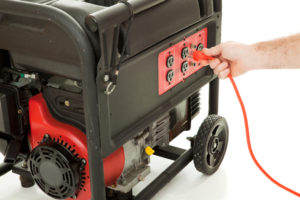
Use generators safely following severe weather
Rosalie Lewis, a trailblazing postal service supervisor in Louisiana who knew every bayou backroad, her husband John, and three of her family members hunkered down to ride out Hurricane Laura, with winds so powerful it shredded nearby homes. They survived; their house did too. Hours later, four of them were dead from generator fumes.
To date, eight people in Louisiana died from carbon monoxide poisoning, their ages ranging from 24 to 84. In Texas, at least four people died from generator fumes.
Portable generators are useful during power outages. The same gasoline-powered portable generators that keep the lights burning, the freezer cold and the house warm when a storm shuts off the electricity, can also kill you in minutes if you fail to follow safe practices.
Many homeowners are unaware that the improper use of portable generators can be risky. The most common dangers associated with portable generators are carbon monoxide (CO) poisoning, electrical shock or electrocution and fire hazards. Most of the deaths and injuries associated with portable generators are from CO poisoning from generators used indoors or in partially enclosed spaces.
Statistics show that during and following major storms and natural disasters, there’s an increase of CO poisoning cases. A study published by researchers at the New York City Poison Control Center in the journal Clinical Toxicology reveals a spike of 437 cases of carbon monoxide poisoning reported in emergency rooms of the city’s hospitals during the two weeks following Hurricane Sandy. And according to a report from scientists at the U.S. Centers for Disease Control and Prevention, some of the largest CO poisoning spikes reported were from ice storms in Kentucky in 2009, Hurricane Ike in 2008 and Hurricane Katrina in 2005.
The spike in CO poisoning seen after major storms, hurricanes and other weather-related disasters might not seem obvious — after all, the storms don’t blow in carbon monoxide. The culprit is people ignoring warnings and putting themselves at risk. When used correctly, and in properly ventilated spaces, portable fuel-burning generators, gas grills and kerosene lamps offer a safe source of power, heat and light. But problems arise when generators and heaters are used in small, confined spaces too close to living quarters. Widespread power outages in the days after a natural disaster find many people resorting to heating their homes using ovens and charcoal grills, adding the risk of fire in addition to the danger of carbon monoxide.
Did you know?
Statistics from the U.S. Centers for Disease Control and Prevention show that there is a spike in carbon monoxide poisoning immediately following a natural disaster or power failure.
Generators spit out an alarming amount of carbon monoxide. Just one can produce the same amount as 100 cars, according to the National Institute of Standards and Technology.
According to a 2013 report Consumer Product Safety Commission, portable generators were involved in the majority of carbon monoxide deaths — 85 percent or 800 out of 931 deaths — during the 14-year period from 1999–2012.
Chapter 27 of the 2018 International Building Code addresses emergency and standby power systems and generators. The building and fire codes may require an emergency generator to provide power for systems that will protect human life, such as egress lighting or fire detection and alarm systems.
Hurricane and tropical storm dangers don’t pass once the winds die down and the rain subsides. Many communities will be without power for days or weeks in the aftermath of Hurricane Laura. Downed utility lines and power company blackouts can lead to power outages. Many people turn to a portable generator for a temporary solution without knowing the risks. In addition to the electrical risks associated with portable generators, owners should also be aware of other dangers. Portable generators burn gasoline, propane or another fuel to generate electricity and that combustion creates carbon monoxide exhaust.
Top generator safety precautions
To ensure that local home and business owners use portable generators safely, here are some generator safety tips for protecting your home, your property and your life during and after a natural disaster.
Understand the safety documentation and make sure that only those individuals who have read the product safety instructions operate the portable generator. In addition, take note of all warnings on unit labels and in manuals.
Make a plan beforehand for using the generator, including where it will be located, how long it will be used and who will be responsible for operating and monitoring it — before the weather turns bad.
Use a generator or other gasoline-powered machinery only outdoors in an open, well-ventilated area. Exhaust fumes from gasoline engines—such as those found in generators—contain carbon monoxide. Never use a generator inside, even in an attached structure like a garage or barn. Make sure the generator is placed at least 15 feet from the structure and that the exhaust is pointed away from the building and any windows, doors or vents that could draw the exhaust indoors.
Note: This precaution also applies to generators that are CARB compliant. While they are better at limiting carbon emissions than non-CARB compliant generators, they still give off exhaust fumes that can be harmful if inhaled in large quantities.
 Check that the entire power cord and any extension cord is long enough and in good condition — free of cuts or tears and that the plug has all three prongs, especially a grounding pin. If you use an extension cord, choose an outdoor cord that has a power rating that can accommodate the total load from the appliances and devices powered. Mind where the placement of the power cord and avoid running generator power cords through main pathways as they are potential tripping hazards — if they are inadvertently pulled or snagged, the cord or generator outlet can be damaged. Be sure to keep power cords guarded with cable covers or warning flags when possible.
Check that the entire power cord and any extension cord is long enough and in good condition — free of cuts or tears and that the plug has all three prongs, especially a grounding pin. If you use an extension cord, choose an outdoor cord that has a power rating that can accommodate the total load from the appliances and devices powered. Mind where the placement of the power cord and avoid running generator power cords through main pathways as they are potential tripping hazards — if they are inadvertently pulled or snagged, the cord or generator outlet can be damaged. Be sure to keep power cords guarded with cable covers or warning flags when possible.
Keep the generator and the surrounding area clean and free of debris. Remove all grease, ice, snow or materials that could create slippery conditions around the unit. Remove any rags or other materials that could create a potential fire hazard. Carefully clean up any gas or oil spills before starting your generator.
Exposure to water can damage the generator and people. Beware of moisture, keep the generator dry, do not use in rain, snow or wet conditions and avoid operating a generator near standing water. If the standing water is exposed to electricity, anyone nearby is at risk of potential shock. To avoid electrocution, operate the generator on a dry surface under an open canopy-like structure, such as under a tarp held up on poles. Water seeping into unprotected outlets can cause breakers to trip or short circuits. Do not touch the generator with wet hands.
If leaving the generator unattended, be sure to secure the generator on a flat surface, in which there is no chance of rolling, tipping or sliding to prevent it from moving out of position and causing a potentially hazardous situation. Lock all wheels, or if no locks are available, inserting wedges under all tires to stop them from rolling. Position the generator out of the way of frequently used pathways to prevent accidental bumping, which can cause it to tip or roll.
Generators become hot when operating, so avoid touching them, and keep children and pets away from them. Turn off the generator and let it cool down before refueling. Gasoline spilled on hot engine parts could ignite. Never refuel a generator while it is running.
Store fuel for the generator only in an approved, correctly labeled and properly sealed safety fuel container in a well-ventilated area outside the building or living area and far away from heat sources such as the generator, a furnace or a water heater. Keep fuel containers out of the way of heavily trafficked areas. Do not smoke or use open flame near an open generator tank or gas can. Keep a fire extinguisher nearby and know how to properly use it. Use the type of fuel recommended in the instructions or on the label on the generator. Local laws may restrict the amount of fuel you may store, or the storage location. Ask your local fire department.
Regularly service the generator and when performing maintenance keep the machine turned off when possible, use extreme caution when working on electrical components, and don’t work on the equipment when fatigued. If replacement parts or repair service is required, contact a certified technician familiar with the generator brand before starting.
Install battery-powered carbon monoxide detectors/alarms in central locations on every level of the structure and outside sleeping areas to provide early warning of accumulating carbon monoxide. Test the devices regularly. Test the batteries frequently and replace when needed. Follow manufacturer’s instructions for correct placement and mounting height. If the carbon monoxide alarm sounds, move quickly to a fresh air location outdoors or by an open window or door. Call for help from the safe location and remain there until emergency personnel arrive.
Be sure that your generator is properly grounded. It’s a good idea to attach it to a portable ground fault circuit interrupter (GFCI) that will stop the flow of electricity if someone is being shocked. Even a properly connected portable generator can become overloaded, resulting in overheating or generator failure. Be sure to read the instructions.
Don’t overload outlets and don’t exceed the generator’s power rating or you may damage the generator and any equipment that’s hooked up to it. Never try to use the generator to power the house wiring by plugging it into a wall outlet. Known as “backfeeding” this practice can endanger utility workers, neighbors and household members by sending unexpected, uncontrolled current through the lines. Overloading a generator can also cause fires.
Plug appliances directly into the generator, or use a heavy duty, outdoor-rated extension cord that is rated (in watts or amps) at least equal to the sum of the connected appliance loads. If necessary, stagger the operating times for various equipment to prevent overload. Disconnect and shut down all equipment that’s hooked up to the generator before you shut it down.
For additional disaster planning resources, visit our Hurricane Resources webpage or our Building Safety Month webpage.









